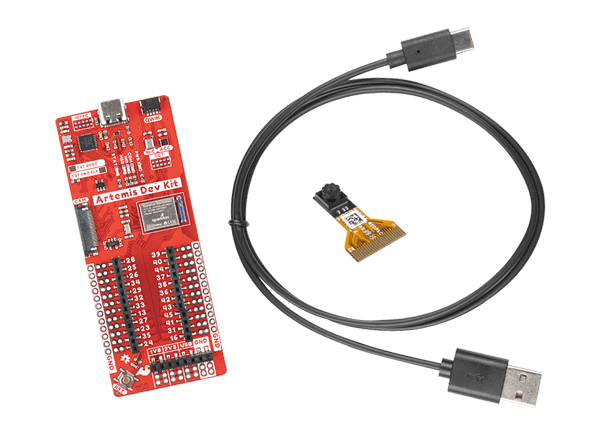- support@husseinkey.com
- livechat
SparkFun Artemis Development Kit with Camera is the latest board to be released around the SparkFun Artemis Module, and it allows access to more software development features than previous Artemis based boards. Recommended software used to program the Artemis Development Kit are the Arduino IDE, Arm® Mbed™ OS (Studio and CLI), and AmbiqSDK. An updated USB interface (MKL26Z128VFM4 Arm® Cortex®-M0+ MCU, from NXP) allows the SparkFun Artemis Development Kit to act as Mass Storage Device (MSD), Human Interface Device (HID), and Communication Port (COM).
The Artemis Module provides a Cortex®-M4F with BLE 5.0 running at 48MHz with an available 96MHz turbo mode and power as low as 6uA per MHz (less than 5mW). The SparkFun Artemis Module is fully FCC/IC/CE certified with 1M flash and 384k RAM that gives plenty of room for the user’s code. The flexibility of the Artemis module starts with an Arduino core. The user can program and use the Artemis module just like they would an Uno or any other Arduino. Additional functionality stems from the ability of the Artemis Development Kit to run RTOS, such as the Arm Mbed OS or the AmbiqSDK.
Attached to the “Qwiic” I2C bus is a LIS2DH12TR MEMS accelerometer (for gesture recognition) and a digital MEMS microphone. It also includes an edge camera connector for the Himax CMOS imaging camera to experiment with always-on voice commands and image recognition with TensorFlow and machine learning. All of the Artemis Development Kit pins are broken out to 0.1″ spaced female headers (i.e., connectors). There are also two rows of breakout pins with 0.1″ pitch spacing for headers and a 0.08″ pitch spacing to clip on IC-hooks, used by most logic analyzers. Additionally, the Silk on the back of the Artemis DK acts as a chart to show pins by functionality (peripherals, ADC, PWM, UART0, & UART1) and act as an aid while developing software. The board is powered & programmed via USB-C, and includes a Qwiic connector to make I2C easy and is fully compatible with SparkFun’s Arduino core to be programmed under the Arduino IDE.




